Freshwater ecosystems are among the most threatened habitats in the world [1]. This is the result of many factors that, individually and in combination, directly affect the degradation of freshwater ecosystems. The biggest problem for these habitats is climate change. Its consequence is drying up, as well as many anthropogenic negative impacts, such as eutrophication, drainage, introduction of invasive species, and overall environmental degradation [1]. Given these facts, species inhabiting sensitive aquatic environments are among the most endangered plant and animal species in the world.
The Czech Republic is home to many plant and animal species that are threatened with extinction. The goal of nature conservation is to ensure that all of these species survive in their natural habitats. The ways to achieve this goal can be different: passive (legislative) protection, delimitation of protected areas, the necessary management. However, for some species, these tools alone are not sufficient and need to be carefully complemented and coordinated with other types of measures, including, for example, captive breeding and reintroduction into the wild. For these species, rescue programmes (RPs) are being prepared. These RPs aimed at conserving endangered species are a very popular tool, increasingly used both in our country and abroad [2]. Their advantage is that, for example, the protection of one species often has a positive effect on other species inhabiting the same habitat – the concept of the so-called umbrella species [3].
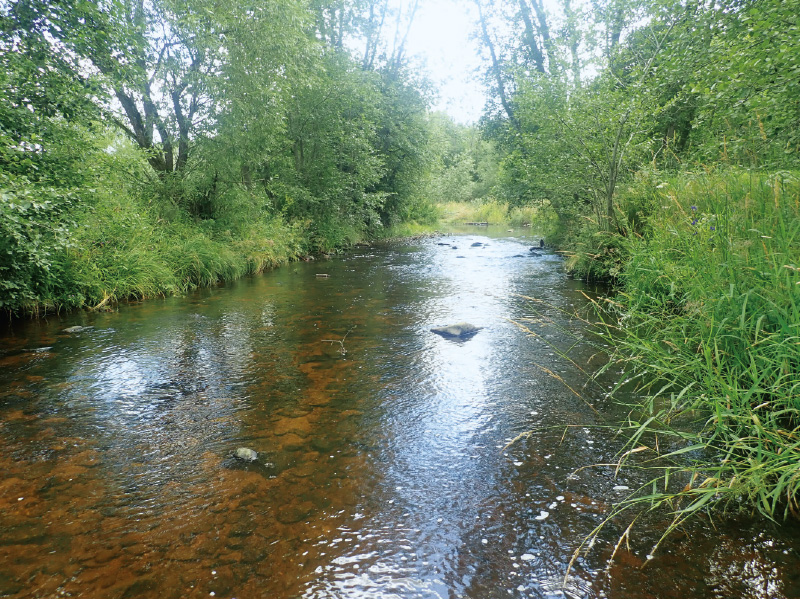
Fig. 1. The Blanice River – habitat of the freshwater pearl mussel (photo: K. Římalová)
Therefore, RPs are understood as temporary projects at the national level, the purpose of which is to achieve an increase of abundance of the affected species above the level of threat of extinction by combining various types of measures. This level varies for individual species due to the different types of distribution of residual populations, the species ecology, the strength of the influence of threatening factors, etc. After achieving the set quantitative goals, the RP is terminated. However, it can also be terminated in the event of its failure (extinction of the species) or its inoperability proven during implementation [4]. Other active instruments in nature conservation include regional action plans (RAPs). These are essentially RPs at the regional level, which are developed for regionally endangered species or for nationally endangered species with a regional occurrence. In addition to the RP and RAP for the most endangered species, there is a need to address in a coordinated manner issues related to the protection of other specially protected species, where there is a conflict between human economic interests and the impact of these species. So-called management plans have been proposed for these species [4].
There are many plants and animals in the Czech Republic that are directly threatened with extinction, and many of them would certainly deserve the support of RPs. However, in order for a species to be a so-called candidate species for an RP, it must meet several criteria that are given by Act No. 114/1922 Coll., on Nature and Landscape Protection; e.g., it must be included among specially protected species according to Decree No. 395/1992 Coll. [19], or the criterion is determined by the Concept of Active Species Protection Instruments [5], such as the fact that the causes of the threat to the species are permanent and removable, etc. These currently selected candidate species are also part of the aforementioned Concept [5], which summarizes the approach to the preparation and implementation of RP, management programmes, and RAP.
Each RP includes chapters on the species taxonomy, biology, and ecology, which describe the demands on the environment, way of life, and the cause of the threat to the species. This is followed by the chapter RP objectives and RP action plan, which is its most important and practical part. The action plan deals with specific measures in the management of the habitat and the species, species monitoring, and research and education, which are an integral part of the RP.
There are currently 14 RPs adopted in the Czech Republic (seven for plants and seven for animals), two of which are RPs for animals related to water. The first is The Freshwater Pearl Mussel Rescue Programme. The current version was approved in 2013 and is now the third stage; the first stage of the Margaritifera rescue programme [6] was running from 1993, followed by the second stage [7] from 2000. The Freshwater Pearl Mussel Rescue Programme is thus the oldest approved and still ongoing programme. The second water-related programme is the Stone Crayfish Rescue Programme, which is the newest approved programme in the Czech Republic (in 2024).
FRESHWATER PEARL MUSSEL
The freshwater pearl mussel (Margaritifera margaritifera) is a long-living freshwater mussel that is protected in the Czech Republic by Act No. 114/1992 Coll., on the Protection of Nature and Landscape [20] and the European Habitats Directive – 92/43/EEC [21] within the NATURA 2000 system. In the Czech Republic, the freshwater pearl mussel was previously found in the Vltava, Elbe, Oder, and Danube river basins, often in colonies of 10,000 to 100,000. Currently, its main distribution is limited to a few sites in southern and western Bohemia.
The average lifespan of freshwater pearl mussels in our conditions is around 50 to 80 years, depending on the quality of the water environment. The freshwater pearl mussel life cycle is quite complicated; for its successful development, the parasitic larval stage of the species needs a healthy population of host fish – brown trout (Salmo trutta m. fario). Juvenile freshwater pearl mussels spend the first part of their lives buried in the gravel-sand riverbed and only emerge on the surface when almost adult (Fig. 2). In all developmental stages, the freshwater pearl mussel is dependent on the quality of the aquatic environment and the associated natural communities. In addition to the requirements for water without pollution, its existence and reproduction depend on the availability of food, which is organogenic detritus arising in adjacent habitats. In practice, therefore, the protection of the freshwater pearl mussel includes not only measures supporting the population of the species and its hosts but also measures improving the quality parameters of the aquatic environment, including the surrounding terrestrial habitats with a connection to this environment. Due to the significant decrease in the number of sites and the overall deterioration of their condition in the recent past, which has been documented since at least the 1950s, systematic activities aimed at protecting the populations and habitat of the freshwater pearl mussel were initiated in the 1980s. These were mainly locations in the Prachatice region, where the largest colonies of freshwater pearl mussel of Central European importance have been preserved to date. The decline of freshwater pearl mussel populations and the loss of quality habitats is not just a matter for the Czech Republic, but a pan-European problem [4].
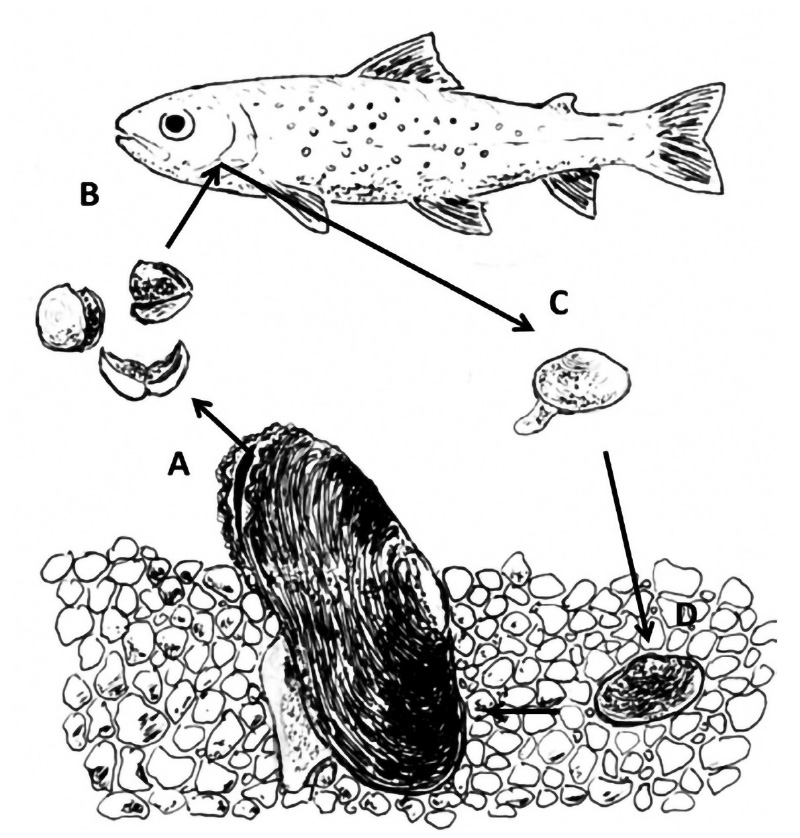
Fig. 2. The freshwater pearl mussel reproductive cycle. A – a sexually mature freshwater pearl mussel excreting a parasitic juvenile stage (glochidia), B – the glochidia attach to the gills of the host fish, where they metamorphose, C – after approximately a year, the juvenile freshwater pearl mussel falls off the host and subsequently burrows into the bottom substrate – D (illustration: M. Bílý)
The RP objectives are based on the idea of nature conservation ecosystem concept, which consider the conservation of Margaritifera margaritifera to be successful only if it is conserved in the Czech Republic in such a state that it is viable as a species and capable of independent reproduction in natural conditions. The conservation of the species in the Czech Republic can be considered successful if at least two of the three Conservation Units (Aš, Blanice, Malše populations; division based on genetic tests) manage to achieve a state where natural reproduction of the freshwater pearl mussel will successfully take place in conditions close to nature.
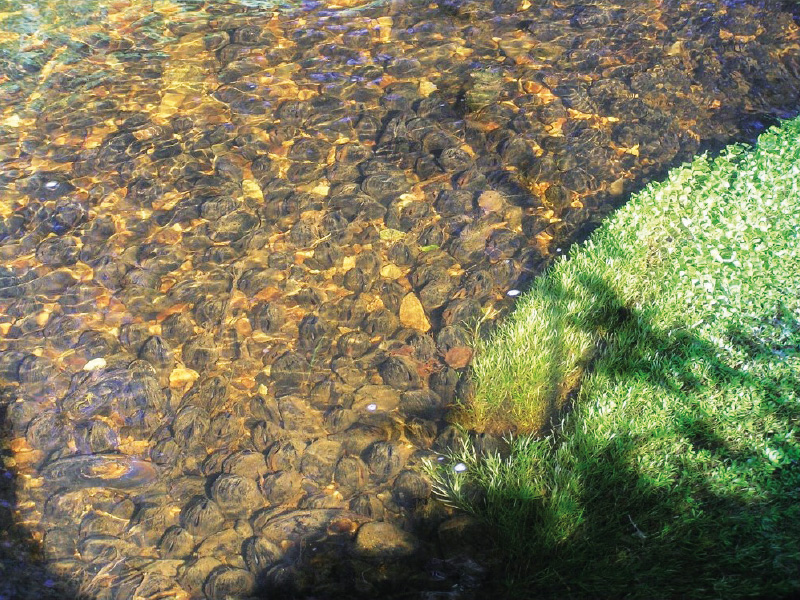
Fig. 3. A colony of freshwater pearl mussels (photo: O. Simon)
Currently, in all locations in the Czech Republic where freshwater pearl mussels occur, semi-natural breeding of old freshwater pearl mussel populations is taking place in parallel with targeted interventions to improve the condition of entire freshwater pearl mussel streams. Targeted interventions include, in particular, measures to improve water quality, anti-erosion measures, and changes in vegetation cover around springs and other parts of the stream, associated with the adjustment of forest management plans. Physico-chemical water parameters are measured at all monitored locations with the freshwater pearl mussel occurrence. Management of the breeding and reproductive features in the Blanice, Lužní stream, and Zlatý stream continues in the form of the cross-section maintenance, food channels, mowing, and subsequent composting of the mowed material, including the return application of compost to breeding or food features. The total number of freshwater pearl mussels at individual monitored sites in the Czech Republic is approximately 14,500 individuals. Subadult individuals, which originate from natural reproduction, are currently found in very small numbers in the Blanice, Malše, and Rokytnice near Aš town [2].
STONE CRAYFISH
The stone crayfish (Austropotamobius torrentium) is a specially protected species according to Act No. 114/1992 Coll., on the Protection of Nature and Landscape, classified as critically endangered according to Decree No. 395/1992 Coll., and a critically endangered species according to the Red List of Invertebrates of the Czech Republic [8]. At the European Union level, it is a priority species protected by Council Directive 92/43/EEC on the conservation of natural habitats and of wild fauna and flora [9, 10].
Although the occurrence of the stone crayfish in our country is rarer than the occurrence of the noble crayfish (Astacus astacus), its original distribution in the Czech Republic is not known. The stone crayfish used to be even considered a non-native species and its sites of occurrence are being constantly discovered. As of the end of 2024, 38 sites of its occurrence were registered [10].
As a critically endangered species, the stone crayfish faces many negative factors. The most significant of these are crayfish plague and habitat loss. Crayfish plague, a disease caused by the oomycete Aphanomyces astaci, is fatal to our crayfish species [11]. There is currently no effective treatment for this disease and under current conditions it is essentially impossible to prevent its spread. However, it is necessary to try to limit or slow down this spread. The primary host of this pathogen is non-native and invasive species of crayfish originating from North America, which are themselves resistant to the infection but are its vectors. There are currently three invasive crayfish species in the Czech Republic – signal crayfish (Pacifastacus leniusculus), spinycheek crayfish (Faxonius limosus), and marbled crayfish (Procambarus virginalis). However, crayfish plague can also be transmitted by the Chinese mitten crab (Eriocheir sinensis) [12, 13]. Moreover, these species are strong competitors of native crayfish species (e.g. in food, shelter, etc.). A fundamental problem is that to transmit crayfish plague to a location, the presence of infected crayfish is not necessary; the spores can survive in water for up to one month without a host [14]. Therefore, infected water, fishing equipment, machines, or animal fur are sufficient to spread the disease. In the last five years alone, we have lost up to 20 % of the stone crayfish population in the Czech Republic due to crayfish plague [15].
Although crayfish plague is a major threat, habitat loss is often a more fundamental problem; however, it has a much higher potential for elimination. These include inappropriate interventions in riverbeds, water pollution, and siltation of riverbeds with fine-grained material. These negative factors are also responsible for the disappearance of several locations where stone crayfish occur [10, 16].
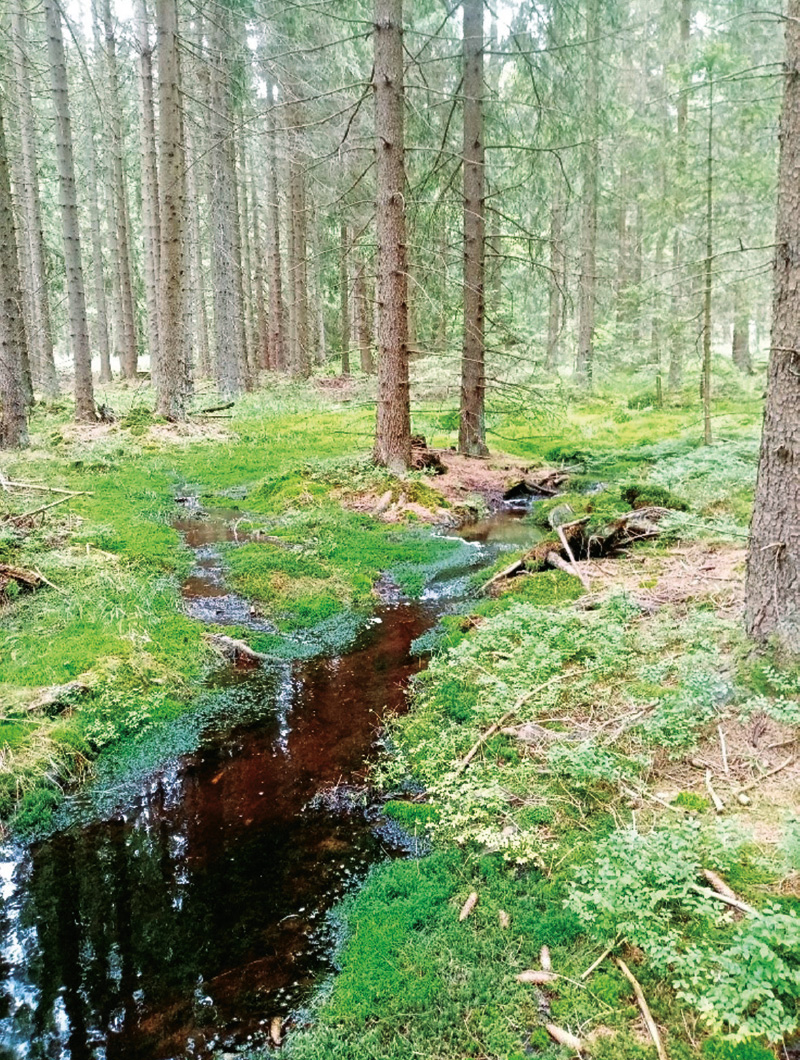
Fig. 4. An example of stone crayfish habitat (BRDY PLA, photo: J. Hronková)
For these reasons, the RP for the stone crayfish establishes measures which can positively influence the population status of this critically endangered crustacean in the Czech Republic. Given the negative factors affecting the stone crayfish, most of the measures concern management of its habitat. It is necessary to ensure satisfactory water quality, which will be influenced by the construction and parameters of new and existing wastewater treatment plants, to further eliminate poisoning, to prevent silting of the riverbeds, and also to actively manage the hydromorphological properties of the riverbeds. Active species management (i.e. the individual as such), such as ex situ breeding, is not the goal of this RP. Management of the species will only be carried out in the event of a crisis, such as necessary rescue transfers in the event of watercourse poisoning, drying out, during riverbed modifications, or as prevention against approaching crayfish plague [10]. However, species management is also related to efforts to slow the spread of crayfish plague and to eliminate and eradicate invasive crayfish species, as well as mammals, such as the northern raccoon [17].
Despite all these measures, public outreach and research activities cannot be neglected. Education is essential in the fight against invasive species, and greater awareness among fishermen, watercourse managers, and the general public can have a very significant impact on the spread of invasive crayfish species. People often rescue invasive crayfish species, thinking they are our protected species, and unknowingly help spread the devastation that crayfish plague brings to populations of native crayfish species [10, 18].
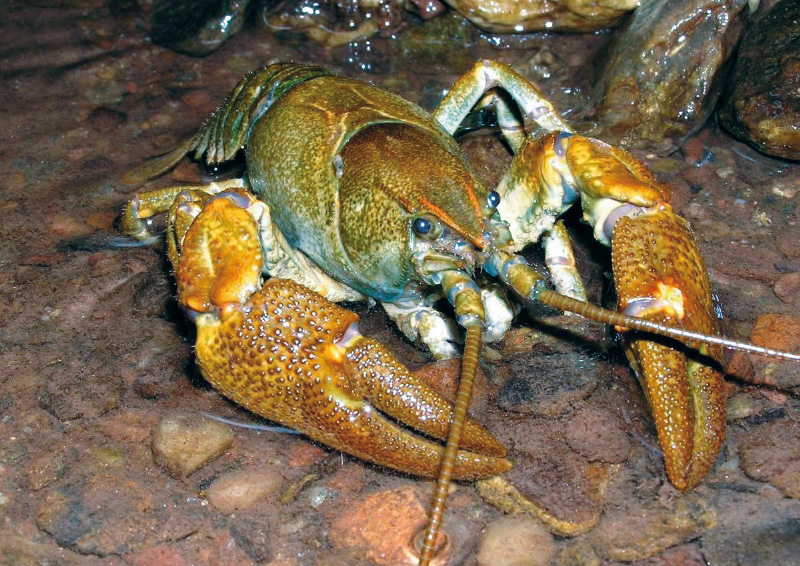
Fig. 5. Stone crayfish (photo: M. Štambergová)
As already mentioned, watercourses are one of the most endangered habitat types worldwide. They represent a complex and highly sensitive environment that is home to a huge number of protected and unprotected plant and animal species. By protecting specially protected species, such as the freshwater pearl mussel and the stone crayfish, we protect all animal and plant species associated with this habitat. With their sensitivity to environmental conditions and bioindication abilities, the freshwater pearl mussel and stone crayfish are very important umbrella species for aquatic habitats [3, 4, 10].
Detailed information on the annual evaluation of the RP for the freshwater pearl mussel and the exact wording of both RPs can be found on the Nature Conservation Agency website – www.zachranneprogramy.cz for individual species in the “Download” section.
Acknowledgements
This article is implemented within the framework of project No. SS02030027 “Water systems and water management in the Czech Republic under climate change conditions (Water Centre)” with state support from the Technology Agency of the Czech Republic and the Ministry of the Environment within the “Environment for Life” Programme.
An informative article that is not subject to peer review.
